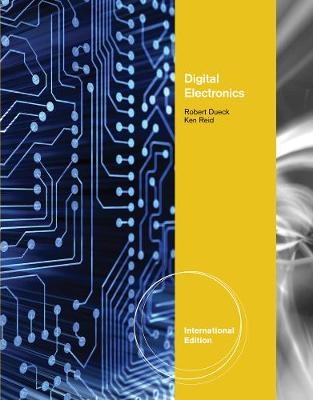
Digital Electronics, International Edition
Delmar Cengage Learning (Verlag)
978-1-111-30820-9 (ISBN)
- Keine Verlagsinformationen verfügbar
- Artikel merken
DIGITAL ELECTRONICS, International Edition is your all-in-one guide to the exciting world of digital electronics, from basic electrical theory and digital logic to hands-on, high-tech applications. Designed to support Project Lead the Way®'s (PLTW) innovative DE course, this dynamic text prepares you for college and career success in STEM, (Science, Technology, Engineering, and Math. The text introduces key concepts such as electrical shop practices and electrical theory, lets you build confidence by exploring key principles and applying what you learn, and helps you develop strong skills in circuit analysis, design, and troubleshooting. A wealth of examples and exercises are included to support your learning, and many feature Multisim™ integration to help you visualize and analyze circuits—including combinational and sequential circuits—before you construct them. Other proven learning tools are provided to make mastering the material easier, including self-check problems in every chapter, "Bring it Home" questions covering the basics, and challenging "Extra Mile" problems to help you deepen your understanding and hone your skills. DIGITAL ELECTRONICS is an ideal choice to support your STEM success!
Robert Dueck received his B.Sc. degree in electrical engineering from the University of Manitoba in Winnipeg, Canada, and worked for several years as a design engineer at Motorola Canada in Toronto. He began teaching in 1986, specializing in digital and microcomputer subjects in the Electronics and Computer Engineering Technology programs at Seneca College in Toronto. His first book, Fundamentals of Digital Electronics, was published in 1994, and he has written several additional textbooks. He now teaches digital electronics and related courses at Red River College in Winnipeg. Mr. Dueck is a member of the Association of Professional Engineers and Geoscientists of Manitoba (APEGM) and the Institute of Electrical and Electronics Engineers (IEEE). He served as chair of the Winnipeg Section of IEEE in 2002 and was branch counselor of the Red River College Student Branch from 1997-2006. Ken Reid received his B.S. degree in computer and electrical engineering from Purdue University in 1988 and his M.S.E.E. degree in 1994 from Rose-Hulman Institute of Technology. He was also one of the first in the nation to receive his Ph.D. in engineering education from Purdue University in 2009. Prior to beginning his teaching career in 1996, he worked for the U.S. Navy in electronics manufacturing research. In addition to publishing and presenting in the field, Dr. Reid has extensive experience in teaching digital electronics and computer programming, and he is currently Director of Freshman Engineering at Ohio Northern University. He is a Senior Member of the Institute of Electrical and Electronics Engineers (IEEE) and is active in the American Society of Engineering Education (ASEE).
1. ELECTRICAL SAFETY AND COMPONENTS.
Electrical Safety. Working with Electricity. Static Electricity. Voltage and Current in Electronics. Other Safety Issues. Component identification. Resistors. Capacitors. Electronic Assemblies. Solder. Soldering. Quality Solder Connections.
2. INTRODUCTION TO ELECTRICITY.
SI notation. Atomic Structure. Atoms and Electricity. Voltage, Current, and Resistance. Conductors and Insulators. Ohm's Law. Kirchhoff's Voltage and Current Laws. Breadboarding. Circuit Design Software.
3. BASIC PRINCIPLES OF DIGITAL SYSTEMS.
Digital vs. Analog Electronics. Digital Logic Levels. The Binary Number System. Positional Notation. Binary Inputs. Decimal-to-Binary Conversion. Sum of Powers of 2. Repeated Division by 2. Hexadecimal Numbers. Counting in Hexadecimal. Hexadecimal-to-Decimal Conversion. Decimal-to-Hexadecimal Conversion. Sum of Weighted Hexadecimal Digits. Conversions Between Hexadecimal and Binary. Digital Waveforms. Periodic Waveforms. Aperiodic Waveforms. Pulse Waveforms.
4. LOGIC FUNCTIONS AND GATES.
Basic Logic Functions. NOT, AND, and OR Functions. NOT Function. AND Function. OR Function. Active Levels. Derived Logic Functions. NAND and NOR Functions. Expanding NAND and NOR Functions. NAND and NOR Gates as Inverters. Exclusive OR and Exclusive NOR Functions. DeMorgan's Theorems and Gate Equivalence. Logic Switches and LED Indicators. Logic Switches. LED Indicators. Enable and Inhibit Properties of Logic Gates. AND and OR Gates. NAND and NOR Gates. Exclusive OR and Exclusive NOR Gates. Tristate Buffers. Octal Tristate Buffers. Integrated Circuit Logic Gates.
5. COMBINATIONAL LOGIC.
Boolean Expressions, Logic Diagrams, and Truth Tables. Boolean Expressions from Logic Diagrams. Logic Diagrams from Boolean Expressions. Truth Tables from Logic Diagrams or Boolean Expressions. Sum-of-Products (SOP) and Product-of-Sums (POS) Forms. Simplifying SOP Expressions. Reducing Product Terms by Factoring and Cancellation. Reusing Product Terms. Avoiding Redundant Terms. Simplification by the Karnaugh Map Method. Two-Variable Map. Three- and Four-Variable Maps. Grouping Cells Along Outside Edges. Loading a K-Map from a Truth Table. Multiple Groups. Overlapping Groups. Conditions for Maximum Simplification. Don't Care States. Simplification by DeMorgan Equivalent Gates. A General Approach to Logic Circuit Design.
6. COMBINATIONAL LOGIC FUNCTIONS.
Decoders. AND and NAND Gates as Decoders. Binary Decoders. Seven Segment Decoders. Encoders. Priority Encoders. Multiplexers. Demultiplexers. Parity Generators and Checkers. Troubleshooting Combinational Logic Functions.
7. DIGITAL ARITHMETIC CIRCUITS.
Binary Sums and Differences. Signed Binary Numbers. Two's Complement Arithmetic. Half and Full Adders. Parallel Binary Adders. Two's Complement Adder/Subtractor.
8. DIGITAL SYSTEM APPLICATION.
Problem-Solving Techniques. Sample Application: a Small Calculator. Components of the Calculator. Troubleshooting.
9. SEQUENTIAL LOGIC FUNCTIONS.
SR Latches. NAND and NOR Latches. D-type Latches. Edge-Triggered D Flip-Flops. Edge-Triggered JK Flip-Flops.
10. DIGITAL COUNTERS.
Basic Concepts of Digital Counters. Full-Sequence Binary Counters. Truncated-Sequence (Modulus) Counters. Asynchronous Counters. Flip-Flop-based Asynchronous counters. MSI Asynchronous Counters. Synchronous Counters. Flip-Flop-based Synchronous counters. Auxiliary Functions: Load, Clear, Direction (Up/Down). MSI Synchronous Counters. Predesigned Counters for PLDs.
11. STATE MACHINE DESIGN.
State Machines. Moore Machines. Mealy Machines. State Machines with No Control Inputs. State Machines with Control Inputs. Designing a Single-Pulse Generator. Traffic Light Controller.
12. MEMORY SYSTEMS.
Appendix A: Multisim™, Xilinx®, and Altera® Tutorials.
What is a Programmable Logic Device? Multisim™ Tutorial. Xilinx Tutorial®. Altera Tutorial®.
| Erscheint lt. Verlag | 16.10.2011 |
|---|---|
| Verlagsort | Clifton Park |
| Sprache | englisch |
| Maße | 215 x 274 mm |
| Gewicht | 918 g |
| Themenwelt | Sozialwissenschaften ► Pädagogik ► Berufspädagogik |
| Technik ► Elektrotechnik / Energietechnik | |
| ISBN-10 | 1-111-30820-9 / 1111308209 |
| ISBN-13 | 978-1-111-30820-9 / 9781111308209 |
| Zustand | Neuware |
| Haben Sie eine Frage zum Produkt? |
aus dem Bereich


